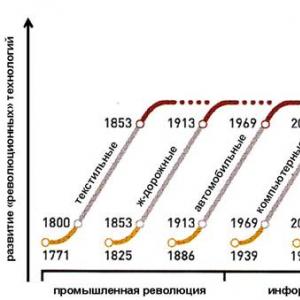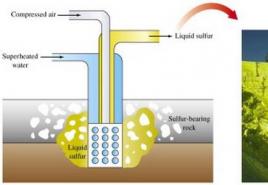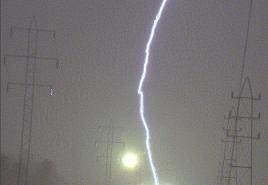History of the invasion of Persian troops. Persian invasion of Hellas
What was decisive in the Greek victory over the invincible Persian army?
1. The march of the army of King Xerxes. It took 10 years before the Persians could begin a new campaign against Greece. It was headed by King Xerxes, who replaced Darius.
In 480 BC. e. Xerxes' army moved to Hellas by land, and a huge fleet accompanied it along the seashore. To cross to the European shore, it was necessary to build a bridge across the Hellespont Strait. The army was so large that, according to Herodotus, “the march of the royal army lasted seven days and seven nights without rest.” Now that the Persians were threatening Greek independence,
Many policies acted against them. The supreme command was entrusted to Sparta.
2. Battle of Thermopylae. The Greeks decided to repel the Persians at the Thermopylae Pass, through which they could penetrate into Central Greece. The mountains in this place come close to the sea, and the narrow passage is easy to defend. It was defended by several thousand Greeks, including a detachment of 300 Spartans. The army was commanded by the Spartan king Leonidas. There were many times more Persians. Xerxes sent a messenger to Leonidas, ordering him to convey two words: “Lay down your arms!” Leonid also answered with two words: “Come and take it.”
The bloody battle lasted two days. The Persians couldn't
break through, but a traitor was found who led them along mountain paths, and the enemies ended up behind Greek lines. When Leonidas found out about this, he ordered all allies to retreat, while he himself remained with the Spartans and volunteers.
They fought with insane courage and all died in a fierce battle, fighting to the last. And the Persian soldiers were driven forward by the commanders of the detachments with blows of whips.
On the mound, which was poured over the mass grave, they placed a statue of a lion (Leonidas means “lion” in Greek) and made the inscription: “Traveler, inform Lacedaemon1 that we lie here, having honestly fulfilled the law.”
"Lakedaemon is another name for Laconia.
3. Battle of Salamis. Once in Central Greece, the Persian army moved towards Athens. Residents with luggage abandoned their houses and loaded onto ships. Women, children and old people were sent to neighboring islands. All the men were preparing for battle.
Themistocles wanted to force the Persian fleet to engage in battle at the narrowest point of the Strait of Salamis. To do this, it was necessary to deceive the Persians, make them believe that the Greek fleet was frightened by the approach of the enemy and was fleeing. This trick was a success. Themistocles sent his faithful slave to Xerxes to inform the king that the Greeks were planning to flee. Xerxes believed and ordered his ships on the night before the battle to take the exits from the strait in secret from the Greeks.
At dawn, the Greeks began to retreat, but as soon as they disappeared from sight of the Persians, Themistocles ordered the ships to form a battle formation. Convinced that the Greeks were fleeing, the Persians entered the strait.
The Athenian ships quickly attacked the advanced enemy ships. They rammed some, broke the oars of others. Light Greek triremes easily bypassed heavy enemy ships.
The Persians fought for glory, booty, rewards from the king, the Greeks - for freedom. They saw columns of black smoke rising above the burning houses and temples of Athens - these were Persian troops plundering and burning their hometown. Nearby, on the island of Salamis, their relatives were. The Greeks had to either die or become slaves. This increased their strength; no one thought about the danger.
King Xerxes himself provided involuntary help to the Greeks. He was so confident in the victory of his fleet that he decided to watch the battle from a high coastal hill. But the Persian ships could not withstand the blow of the Athenians and began to retreat, colliding with each other.
The king was the first to realize that his fleet was being defeated. In grief and anger he left the hill. The Persians saw that the royal banner that was flying over the hill had disappeared, and were completely at a loss. The Persians lost more than two hundred ships in this battle. Xerxes left part of the army to winter in Greece, while he himself retreated to Asia Minor.
4. Battles of Plataea and Mycale.
The glorious victory at Salamis and the retreat of the Persians inspired the Greeks. Now it was possible to think about expelling all Persian forces from Greece. The ranks of the Greek army gathered warriors from more than forty city states.
In 479 BC. e. The battle of Plataea (a town in Boeotia) took place. The battle was stubborn and bloody. But the Greek hoplites were better trained, had more advanced weapons, and fought for freedom. And they won.
The Battle of Plataea is no less important in its results than the Battle of Salamis. The Persian army suffered greatly in the battle. Her retreat from Greece began.
According to legend, on the same day the Persian fleet was defeated in a naval battle at Cape Mycale (in Asia Minor).
The battles of Plataea and Mycale end the first period of the Greco-Persian Wars. Military operations are transferred to Asia Minor. Here, too, the gradual liberation of Greek cities begins.
5. Results of the Greco-Persian battles. The war continued for a long time, but with interruptions. Finally, in 449 BC. e. peace was made. Under its terms, the king recognized the independence of all Greek cities of Asia Minor. The Persian fleet was prohibited from sailing in the Aegean Sea. Athens emerged from the war as the strongest maritime state in Greece.
Description of the Battle of Salamis
participant in the battle of Aeschylus in the tragedy "The Persians"
(The story is told from the perspective of the messenger sent by Xerxes to his mother)
The entire fleet was in a hurry, and at the same time a loud cry was heard: “Forward, sons of Hellas! Save your homeland, save your wives, your children, your father’s temples, the tombs of your ancestors: the battle now is for everything!” Persian cries also rushed towards them... At first the Persian army stood firm. When the ships crowded together in the strait, they could not give help to each other, and with their copper noses they struck their own - then they all died. And the Hellenes skillfully struck them all around... And the ships sank.
How could the Persians - participants in the battles with the Greeks - explain their defeat?
1. How did the campaign of Xerxes change the life of the Greek city-states? 2. How did the ancient Greeks understand the words “honestly fulfill the law”?
3. What are the reasons for the victory of the Greeks in the Battle of Salamis?
4. Indicate the significance of the battles of Salamis, Plataea and Mycale.
5. How do the battles of Salamis, Mycale differ from Thermopylae and Plataea?
1. What was A.V. Suvorov right when he argued: “Fight not with numbers, but with skill”? To what extent does this apply to the Greco-Persian Wars? 2. What actions of the Greeks would you call a feat in the name of freedom? Tell us about them.
LET'S SUM UP __________________________
 |
1. Explain why the Greeks did not have a navy before the Greco-Persian Wars. 2. Did the Battle of Marathon put an end to the aggressive plans of the Persians? Why? 3. How did Themistocles convince the Greeks to build a navy? 4. What helped the small Greek army defeat the Persians? 5. Arrange the events of the Greco-Persian Wars in chronological order: the Battle of Salamis, the Battle of Marathon, the battles of Plataea and Mycale, the Battle of Thermopylae.
Lesson plan on the topic:
"Invasion of Persian troops in Hellas"
Lesson objectives:
Educational:
formation and development of skills that allow you to work with text and historical maps in the classroom
analyze historical source
Educational:
formation of generalization skills
use of displayed information in various sign systems - table, map, audiovisual series
Educators:
development of cognitive activity
ability to communicate in groups
Expected results:
Subject:
They will learn to determine the reasons for the victories of the Greeks, evaluate the results of wars, characterize the personalities of Xerxes and Themistocles;
Get the opportunity to learn to analyze opinions, events, draw your own conclusions, and defend your own point of view with reason.
Metasubject:
Cognitive: will complement and expand knowledge about the Greco-Persian wars (Battles of Thermopylae and Salamis), search for the necessary information;
Communication: apply the rule of business cooperation, take part in collective discussion;
Personal: will maintain motivation for educational activities, show interest in new educational material, and evaluate their own educational activities.
Solvable educational problems : Why were the Greeks able to win the Greco-Persian wars?
Equipment: computer, multimedia projector, screen, presentation for the lesson “Invasion of Persian troops in Hellas.”
During the classes:
I.Organizing time.
II.Creating a problematic situation. Formulating the problem. Versions.
What threat loomed over Greece at the beginning of the 5th century? BC.? Prove that this threat was great. (Invasion of the Persians. Huge army.)
Was there still a danger of invasion after the victory in the Battle of Marathon? Why? (The Persians wanted to take revenge, punish the Greeks for the victory at Marathon and enslave them.)
What year was the Battle of Marathon?
Was Persia still a strong power? Was Greece strong?
(Yes. Persia is a great power uniting many nations. Greece is divided)
Judging by the strengths of the warring parties, what should be the results of the Greco-Persian wars? But the Greeks won.
Problem: Why were the Greeks able to win the Greco-Persian wars?
Any versions, guesses? Write them down in short phrases.
The teacher writes on the board:
The Greeks united;
New military tactics, the emergence of a fleet;
The Art of Generals;
Courage, heroism, etc.
III.Updating knowledge. Activity planning:
Conversation about the features of Greek democracy.
What do we need to know? (new events in the life of the Greeks, how they prepared for wars, results and significance)
Plan for learning new material.
1.Preparing Greece for a new war with the Persians.
2.Invasion of Xerxes’ troops into Greece.
3. Battle in the Thermopylae Gorge.
4.Battle of Salamis.
Finding a solution to the problem.
Independent work with the textbook text. Study the actions of Themistocles.
Expressing opinions.
Many Greeks considered the defeat of the Persians at Marathon to be the end of the war, but the most far-sighted of them thought otherwise. To defend their independence, Greek cities needed to forget about internal strife, unite their forces and create one large powerful army. During these years, an intelligent and energetic citizen of Athens, Themistocles, emerged. He was a participant in the Battle of Marathon and well understood that the Persians would soon invade Greece again. Speaking at the People's Assembly, he said: “Our homeland - Hellas - is divided into dozens of states that often fight with each other. To defeat the Persians, the Greeks must forget mutual enmity and unite." Themistocles traveled to different cities in Greece, and eventually the military alliance he called for was created. The command of the united army was entrusted to the Spartans, since they had the best infantry. The creation of the fleet is associated with the name of Themistocles. Speaking at a public meeting, he said:
If the Persian king moves towards Hellas with his main forces, we will not be able to defeat him on land. Our salvation lies in the creation of a powerful fleet, because the Hellenes are better than other peoples at sailing ships and fighting at sea.
But where to get the money to build a fleet? - asked the Athenians.
“You all know,” answered Themistocles, “that in the south of Attica there are silver mines belonging to the Athenian state. Usually we divide the mined silver among all citizens. I propose to refuse this money and build warships with it.
The popular assembly accepted Themistocles' proposal, and by the beginning of the new war with the Persians, the Athenians had two hundred triremes. The trireme was a shallow-draft ship with three rows of oars. The sails played a supporting role: before the battle they were usually removed by the trireme, thanks to the coordinated actions of 180 oarsmen and a helmsman, it developed speed for those times (up to 18 km), was mobile, capable of making sharp turns, passing through narrow straits without running aground.
Students are provided with images of a trireme on the screen.
The following questions are suggested:
What measures to prepare for a new war with the Persians were carried out at the suggestion of Themistocles?
What is the essence of uniting the Greek city-states into a single army?
2.Invasion of Xerxes’ troops into Greece.
A new campaign against Greece was organized by Xerxes, who became king after the death of Darius. This happened 10 years after the Battle of Marathon. Xerxes had many ships and countless troops recruited from conquered peoples. A huge army of Persians set out from the city of Sardis and Asia Minor. It approached the Hellespont Strait. (which two parts of Eurasia are separated by the strait?). By order of Xerxes, a bridge more than a kilometer long was built. But a strong storm arose and destroyed the bridge. Xerxes was furious, he ordered the execution of the bridge builders, flogging the disobedient sea with whips and, as punishment, lowering iron chains into it. Other craftsmen built a new bridge. They placed 360 ships close to each other at anchors and tied them together for strength. The crossing to the European coast lasted seven days.
Then the army moved along the European coast, and a fleet walked along the coast (Persian ships were heavy and clumsy, adapted for sailing on the open sea). The army was followed by a convoy with food. Xerxes' army invaded northern Greece and began to occupy region after region. The Greeks did not dare to open battle. The only passage between northern and central Greece was Thermopylae. The narrow Thermopylae passage was convenient to defend: to the left of the Greeks almost sheer cliffs rose up, and to the right there was a cliff to the sea. The Greeks built defensive walls and towers. Xerxes was informed that the united Greek army had occupied the Thermopylae Gorge and blocked the Persians' further path. Students are given map No. 1 on the screen. The invasion of Xerxes’ troops into Greece.
Working with a historical map:
Which two parts of Eurasia are separated by the Hellespont?
Show the borders of the Persian state before the start of the war?
List the Greek city-states that took an active part in the war with Persia?
Physical education.
Work in groups:
1 gr.: Battle of Thermopylae.
2 gr.: Salamis battle.
3. Battle in the Thermopylae Gorge (students’ story).
The Greek commanders sent a detachment to Thermopylae with only a few thousand soldiers. It was commanded by the Spartan king Leonidas. He so skillfully directed the actions of his warriors that a huge army of Persians tried for four whole days to conquer the gorge, which was defended only by a small detachment. The Persian soldiers, gripped by fear, ceased to obey their commanders, and they were driven into the attack by blows of whips. Xerxes was furious: his vast army was being defeated.
Students are given fragments on the screen from Herodotus’s work “History” about the Battle of Thermopylae to analyze the historical source.
VII.212...The barbarians attacked in the belief that, given the small number of enemies, they would all be wounded and would not be able to resist, but the Hellenes fought in succession, except for the Phocians. The Phocians were sent to guard the mountain path.
213. Meanwhile, the Persian king did not know what to do. Then a certain Epialtes came to him and, for a reward, showed the Persians the path leading through the mountains to Thermopylae, and thereby destroyed the Hellenes who were there.
220. Leonidas sent his allies to save them from death. It is not appropriate for him and his Spartans to leave the place to protect which he was sent...
222...only the Thespians and Thebans remained with the Lacedaemonians. The Hellenes knew about the certain death that threatened them from the enemy who had bypassed the mountain. Therefore, they showed the greatest military valor and fought the enemy with desperate and insane courage.
To analyze a historical source, it is proposed to use a reminder for working with the text.
Read the text
Divide the text into parts and highlight the main idea in each
Read the text a second time and check that all the main ideas are reflected in the outline
Write the resulting plan in your notebook
Not a single Spartan survived. The Greeks remembered the feat of the Spartans for many centuries. At the site of the battle, they erected a monument, on the pedestal of which they placed the lines of their best poet, dedicated to the fallen heroes:
O traveler, tell the Spartans about our death:
True to our laws, we died here as bones.
The monument was crowned by the figure of a seated lion as a reminder of the Spartan king Leonidas, whose name means “like a lion.” The heroic death of the defenders of the Thermopylae Gorge in 480 BC. e. became a symbol of military courage in world history.
4. Battle of Salamis (students’ story).
Having captured Thermopylae, the Persian army rushed deep into Greece. The Greek commanders understood that the city would not be able to withstand a long siege by a powerful army. Therefore, by decision of the People's Assembly, the inhabitants of the city were transported to the island of Salamis under the protection of the Greek fleet. When the Persians entered Athens, the city was empty. Then Xerxes' soldiers put him to the fire. The Greeks did not consider themselves defeated. Their army and navy were preserved. Themistocles believed that first of all it was necessary to destroy the strong Persian fleet. Therefore, the battle had to take place at sea in the narrow Strait of Salamis. There was enough space for light and fast Greek triremes, but the bulky Persian ships could not move freely there. The naval victory of the Greeks was to decide the fate of the entire war.
However, the Greeks doubted that Themistocles was right. Then Themistocles decided to resort to cunning. He secretly sent a scout warrior to the Persian camp. He was supposed to tell Xerxes supposedly true information that the Greek fleet was going to leave the island of Salamis. The Persian king believed the report and ordered to block the path of the Greek ships. The exits from the Strait of Salamis were closed by Persian ships. The battle in the Strait of Salamis became inevitable.
The presentation and plan of the battle is presented on the slide.
Realizing that he had been defeated, Xerxes feared that the Greeks would cut off his path back to Persia. In Greece he left only a few detachments led by experienced commanders. The vicinity of the city of Plataea was chosen as the site of the battle. The Greek army was commanded by the outstanding Spartan military leader Pausanias. The Battle of Plataea ended the war between the Greeks and the Persians on the Balkan Peninsula. Victory in the wars did not go to the Greeks by chance. The unity of the Greek city-states helped defeat a terrible enemy who far outnumbered them in strength.
IV.Reinforcing new material:
Exercise:Students fill out the time line.
Expressing a solution to a problem.
What conclusion can we draw about the problem? Have we solved the problem of the lesson? Which versions have been confirmed?
5.Homework instruction: paragraph 35, answer the questions.
6 .Creative task: Imagine yourself as an Athenian craftsman turned trireme oarsman or warrior. Describe how the night before the Battle of Salamis went. What role did your ship play in the battle? Pupils do work in groups. After preparation, children “defend” their work.
7. Reflection on activity: summing up, voicing and giving reasons for assessments.
In today's lesson you will learn how the Greeks, despite the numerical superiority of the enemy, were able to defend their independence.
After the death of Darius, his son Xerxes became the ruler of the Persian state. In 480 BC. e. King Xerxes led his hordes to Hellas. Most of Xerxes' warriors were recruited from conquered peoples. The interests of the Persian king and the nobility were alien to them.
A narrow strait separated Europe from Asia. By order of Xerxes, bridges were built to connect both banks, but a storm broke out and demolished these bridges. Xerxes, enraged, ordered the builders' heads to be cut off, and inflicted an unprecedented punishment on the sea. The cries lashed him with whips, saying: “Oh, you bitter sea moisture! Here's to you from our lord! Remember well, the king will cross you, whether you want it or not!” (Fig. 2) Other craftsmen built a new bridge. The crossing to the European coast lasted seven days.

Rice. 2. Crossing the Hellespont ()
A huge army invaded Northern Greece. He was followed by a convoy with food, and herds of bulls were being driven. The Persian fleet was sailing along the coast. This happened 10 years later, in 480 BC. e., after the Battle of Marathon. Having crossed the Hellespont Strait to the European coast, the army moved along the European coast, and having invaded Northern Greece, it began to occupy region after region. The Greeks did not dare to open battle.
The only route that led from Northern to Central Greece was the Thermopylae Pass, which 300 Spartans and 700 Thespians under the command of Leonidas decided to defend, blocking the Persians’ road. The detachment led by Leonidas heroically defended Thermopylae, but could not resist due to the betrayal of one Greek, who led the Persians to the rear of the troops of King Leonidas. Wanting to save the army from defeat, Leonidas gave the order for the immediate retreat of the Greek troops, and he himself, with a detachment of selected infantry of 300 Spartans, fell on the battlefield. At the site of the battle, a monument was erected in the form of a stone lion with the inscription: “Stranger, take the news to all the citizens of Lacedaemon: having honestly fulfilled the law, here we lie in the grave” (Fig. 3).

Rice. 3. Monument to Leonidas and 300 Spartans ()
Having captured Thermopylae, the hordes of Xerxes poured into Central Greece. Plundering its regions, trampling fields, cutting down vineyards and olive trees, the invaders approached Athens.
By decision of the People's Assembly, the inhabitants of Attica hastily left their homes. Many women, old people and children moved to the island of Salamis under the protection of the fleet. Men able to bear arms entered the ships. All of Attica was deserted. The Persians entered Athens, set them on fire, and destroyed the temples. The Persian warships anchored in a bay near Athens. Nearby, in the narrow strait between Salamis and Attica, there was a Greek fleet numbering about four hundred ships. From here one could see how the most beautiful of the cities of Hellas was burning.
At the general council of military leaders, many commanders insisted on withdrawing the fleet to the Isthmus of Corinth to protect southern Greece. Only the Athenian strategist Themistocles convinced them to fight in the Strait of Salamis, where the Hellenes were familiar with every pitfall and all wind directions. He begged to think about the fate of Athenian women and children. The Greeks argued for a long time, not knowing what to do. But at dawn they saw that the exits from the strait were blocked by the Persian fleet. The battle became inevitable.
Xerxes watched his progress, sitting on a golden throne, from the high bank of Attica. The superiority in the number of ships created confidence in victory. Meanwhile, a strong wind rose. He rocked the high-deck ships of the Persians, but was not dangerous to the low triremes. The Greeks dealt the first blows to the enemies.
The battle was described by its participant, the poet Aeschylus. “A loud cry was heard: “Forward, sons of Hellas!” Save your homeland, save your wives, your children, the gods of your fathers, the temples, the tombs of your ancestors: the battle now is for everything!” ...At first the Persian army stood firm; when the ships crowded together in the strait, they could not help each other and struck their own with copper noses - then they all died. And under the wreckage of broken ships, under the blood of the dead, the surface of the sea disappeared” (Fig. 4).

Rice. 4. Battle of Salamis ()
The Salamis victory was decisive in the Greco-Persian wars. After the defeat, Xerxes left Greece, leaving part of the land army in it. And a year later, at the Battle of Plataea, it was defeated. The Greeks defended their independence in a difficult and lengthy struggle.
Bibliography
- A.A. Vigasin, G.I. Goder, I.S. Sventsitskaya. Ancient world history. 5th grade - M.: Education, 2006.
- Nemirovsky A.I. A book to read on the history of the ancient world. - M.: Education, 1991.
- Historylib.org()
- Ancienthistory.spb.ru ()
- Home-edu.ru ()
Homework
- How did the Greeks prepare for the Persian invasion?
- Why was the command of the Greek army entrusted to the Spartans?
- Why did the Greeks defeat the outnumbered Persian army?
State educational institution of the LPR "Seleznevskaya school No. 18"
PUBLIC LESSON
BY HISTORY
« INVASION OF PERSIAN TROOPS ON HELLAS"
(5th grade)
Prepared by: Sklyarova Oksana Sergeevna
a history teacher
Seleznevskaya school No. 18
2016
Lesson "Invasion of Persian troops in Hellas."
Target : Complete the study of the history of the heroic struggle of the Greek city-states with the Persian power, show the heroic struggle of the Greek city-states with the Persian power using the example of the Battle of Thermopylae and the Battle of Salamis, continue to develop the skills to correctly show historical objects on the map, read map diagrams, write a story.
Equipment: Textbook by A.A. Vigasin, G.I. Goder, I.S. Sventsitskaya “History of the Ancient World” § 35. table Battle of Salamis, fragment of the film “Battle of Salamis”
During the classes.
Organizing time .
II. Updating knowledge students on the topic “Victory of the Greeks over the Greeks in the Battle of Marathon”:
1.Why in the beginningVV. BC. Darius the First decided to conquer Hellas?(since the Persian nobility sought new conquests, new lands, wealth.)
2. How did many Greek city policies act when the ambassadors of Darius the First arrived?Many Greek city-states immediately submitted to the troops of Darius.
3. How did the Greeks behave when the Persian ambassadors came to them?
(The Athenians threw the ambassadors off a cliff, the Spartans threw them into a well.)
4.Which cities did the Athenians turn to for help? (The Athenians turned to Sparta and Plataea for help).
5.How did the inhabitants of Sparta behave? The Spartans promised to help later
6.Who was appointed to the position of strategist by the People's Assembly in Athens?The Athenians chose Miltiades, who knew military affairs well, to the position of strategist.
7.What help did the residents of the city of Plataea provide?Only the inhabitants of the city of Plataea sent a thousand soldiers.
8.What was the name of the Greek battle formation before the battle?. They formed a phalanx and fought like mad.
9.When did the Battle of Marathon take place? (The Battle of Marathon took place in 490 BC).
10. How did it end? (The Battle of Marathon ended in victory for the Greeks)
11.What was the significance of the Greek victory at Marathon? (The Greeks defeated the Persians for the first time, and the Persians were no longer considered invincible).
12.What reminds us of the Battle of Marathon these days? (Marathon running, 42 km 195 m)
Now we will play the game “Who is first?” I ask questions, and whoever answers the question first and correctly receives a picture of a kolobok with a smile.
Preparing for a review and generalization lesson .
What does the word polis mean? (A small independent state in Greece).
Who are called helots? (Slaves in Sparta).
What is democracy? (People power).
What does the word Areopagus mean? (Council of Nobles in Athens).
Who were called citizens? (Free Athenians).
Working with the map.
You know and this is not new:
The map is an important foundation.
Battles, actions and countries
You will be shown tirelessly.
If you have a desire,
Let's get started. All attention.
Show on the map the territory of Ancient Greece and its parts. Name them. (Northern, Central, Southern Greece).
Which peninsula is considered Southern Greece? (Peloponnese Peninsula).
Where is the city of Athens? (In Attica).
Where is Sparta? (In Southern Greece, Lakonica region).
Where did the Greeks first defeat the Persians? (In Marathon).
Teacher's summary.
So, we got acquainted with the Battle of Marathon. We learned that thanks to their courage, bravery, and willpower, the Greeks defeated the Persians.
But do you think it was possible to exclude the danger of a new enemy attack?
Of course not. Since the Greeks had money, ships, goods, there was brisk trade in the Aegean Sea, and the Greeks themselves could be turned into subjects of the “king of kings.”
Therefore, Today we will get acquainted with new events from the Greco-Persian troops.
and the topic of the lessonInvasion of Persian troops in Hellas"
Problem task for students:
IV . Introduction to the topic.
Plan:
Preparing the Hellenes for a new war.
Battle in Thermopylae Gorge.
Battle of Salamis.
1. The Athenians were proud of their victory in the Battle of Marathon. But there were new battles with the Persians ahead. Only a few understood this, and among them was Themistocles, the leader of the demos.( Pay attention to fig. us. 165 below). Under his leadership, the Greeks began to prepare for war with the Persians. Themistocles spoke at the national assembly and convinced everyone that the support of democracy was the fleet. The Athenians listened to his opinion and built 200 triremes in a short time. On such a ship there were 180 oarsmen from the Athenian poor.
Themistocles also convinced the Greeks that they needed to unite to fight the Persians. 30 Greek states created an alliance to defend against the Persians. And so in 480. BC. Darius' son Xerxes led his troops to Hellas. A narrow strait separated Europe from Asia. Here Xerxes ordered the construction of a bridge, but a storm arose and the bridge was destroyed. In anger, Xerxes ordered the heads of the bridge builders to be cut off and the sea to be whipped. Other craftsmen built a new bridge. The Persians crossed the new bridge for seven days to the opposite bank. The teacher talks about the Persian crossing of the Hellespont,( Students work with a map ).
(see map) A serious clash with the enemy occurred among the Greeks in the Thermopylae Pass, which separated Northern Greece from Central Greece.(Independent reading by students of the section “Battle in the Thermopylae Gorge” pp. 166-167)
Who led the Greek army that blocked the Persians' path to Thermopylae Gorge? (Tsar Leonidas)
On whose side - the Greeks or the Persians - was there military superiority? quality?
What was the feat of the 300 Spartans?
What are the results of this battle?
Children's answers: A huge Persian army invaded the territory of Northern Greece. A serious clash with the enemy occurred among the Greeks in the Thermopylae Pass, which separated Northern Greece from Central Greece. The united Greek army was led by the Spartan king Leonidas. The Greeks occupied the Thermopylae Gorge and blocked the path of the Persians. Xerxes sent the main forces of the Persian army into a frontal attack, but the Greeks did not retreat. The Persians suffered heavy losses. Xerxes jumped up from his throne three times in fear for his army. All Persian attempts to capture the Thermopylae Gorge ended in failure. On the third day, a local resident came to Xerxes and showed him a bypass path for a reward. Xerxes was delighted and sent his soldiers to the rear of the Greek defenders of Thermopylae. The Hellenes noticed the marching enemy detachment. King Leonidas ordered everyone to retreat, and he himself, along with 300 Spartans, remained to cover the retreat of the Greek troops. 300 Spartans showed courage and heroism in the battle with the Persians. The Spartans fought with King Leonidas until everyone died.
Teacher: The feat of three hundred Spartans saved the Greek army from defeat, but could not save the country from ruin.
The Spartans ordered the withdrawal of troops to the Isthmus of Corinth, separating Central Greece from the Peloponnese. Here, from sea to sea, they began to build a defensive wall.
Attica was given to the Persians without a fight. The Persian cavalry trampled barley and wheat fields, soldiers cut down olive trees and vineyards, and burned villages. Themistocles, in this terrible hour for his homeland, told the Athenians: “The entire adult population must board warships. And women, old people and children must be transported to the island of Salamis under the protection of the navy. The outcome of the war will be decided in a naval battle." (See map)
The Athenians did as Themistocles advised.
When the Persians entered Athens, the city was empty. By order of Xerxes, Athens was set on fire and its temples were destroyed. The Persian warships anchored in a bay near Athens.
Nearby, in the narrow strait between Salamis and Attica, there was a Greek fleet of about 400 ships. From here one could see how the most beautiful of the cities of Hellas was burning.
And so, on the deck of one of the triremes, a military council took place. The commander of the combined army was a Spartan, he stated that he was ordering to sail to the Isthmus of Corinth to protect southern Greece. Themistocles began to object to the commander, urging him to fight in the Strait of Salamis.
Read the text on page 167 below, “The Mistocles’ Cunning the Day Before Battle of Salamis."
Now let’s look at an excerpt from the film “The Battle of Salamis”
Thus ended the Battle of Salamis. Xerxes, leaving part of his army, left Greece. In 479 BC. near the city of Plataea, the remaining Persian army was defeated. The Battle of Salamis became decisive during the Greco-Persian wars. The Greeks, in a difficult struggle, defended their independence and saved their homeland from the enemy.
Was Themistocles right? How did his talent as a strategist manifest itself?
and the speaker? What legendary hero can we compare Themistocles with?
and for his cunning? (WITH
Odysseus).
V . Reinforcing what has been learned in the lesson.
At least a little tired,
Shown the power of knowledge
Well, one more step
We'll reinforce the lesson.
1. Guys, what battles during the Greco-Persian wars did we talk about today? (About the Battle of Thermopylae Gorge and the Battle of Salamis).
Now let's fill out the table and find out in which battles did the Greeks defeat the Persians?
Filling out the table “Greco-Persian Wars”
date
Battle
Results of the battle
490g. BC.
Marathon Battle
Greek victory
480g. BC.
Battle in Thermopylae Gorge
Persian victory
480g. BC.
Battle of Salamis
Greek victory
The Greeks defended their independence in a difficult and lengthy struggle.
IX . Checking the problem task, reflection.
Why did Greece, such a small country, manage to defeat such a huge power as Persia?
How do you think,
VI . Lesson summary.
Grading.
Homework: P. 35 of the textbook, learn the terms.
Write a story on behalf of a Greek about any battle (optional).
In today's lesson you will learn how the Greeks, despite the numerical superiority of the enemy, were able to defend their independence.
After the death of Darius, his son Xerxes became the ruler of the Persian state. In 480 BC. e. King Xerxes led his hordes to Hellas. Most of Xerxes' warriors were recruited from conquered peoples. The interests of the Persian king and the nobility were alien to them.
A narrow strait separated Europe from Asia. By order of Xerxes, bridges were built to connect both banks, but a storm broke out and demolished these bridges. Xerxes, enraged, ordered the builders' heads to be cut off, and inflicted an unprecedented punishment on the sea. The cries lashed him with whips, saying: “Oh, you bitter sea moisture! Here's to you from our lord! Remember well, the king will cross you, whether you want it or not!” (Fig. 2) Other craftsmen built a new bridge. The crossing to the European coast lasted seven days.

Rice. 2. Crossing the Hellespont ()
A huge army invaded Northern Greece. He was followed by a convoy with food, and herds of bulls were being driven. The Persian fleet was sailing along the coast. This happened 10 years later, in 480 BC. e., after the Battle of Marathon. Having crossed the Hellespont Strait to the European coast, the army moved along the European coast, and having invaded Northern Greece, it began to occupy region after region. The Greeks did not dare to open battle.
The only route that led from Northern to Central Greece was the Thermopylae Pass, which 300 Spartans and 700 Thespians under the command of Leonidas decided to defend, blocking the Persians’ road. The detachment led by Leonidas heroically defended Thermopylae, but could not resist due to the betrayal of one Greek, who led the Persians to the rear of the troops of King Leonidas. Wanting to save the army from defeat, Leonidas gave the order for the immediate retreat of the Greek troops, and he himself, with a detachment of selected infantry of 300 Spartans, fell on the battlefield. At the site of the battle, a monument was erected in the form of a stone lion with the inscription: “Stranger, take the news to all the citizens of Lacedaemon: having honestly fulfilled the law, here we lie in the grave” (Fig. 3).

Rice. 3. Monument to Leonidas and 300 Spartans ()
Having captured Thermopylae, the hordes of Xerxes poured into Central Greece. Plundering its regions, trampling fields, cutting down vineyards and olive trees, the invaders approached Athens.
By decision of the People's Assembly, the inhabitants of Attica hastily left their homes. Many women, old people and children moved to the island of Salamis under the protection of the fleet. Men able to bear arms entered the ships. All of Attica was deserted. The Persians entered Athens, set them on fire, and destroyed the temples. The Persian warships anchored in a bay near Athens. Nearby, in the narrow strait between Salamis and Attica, there was a Greek fleet numbering about four hundred ships. From here one could see how the most beautiful of the cities of Hellas was burning.
At the general council of military leaders, many commanders insisted on withdrawing the fleet to the Isthmus of Corinth to protect southern Greece. Only the Athenian strategist Themistocles convinced them to fight in the Strait of Salamis, where the Hellenes were familiar with every pitfall and all wind directions. He begged to think about the fate of Athenian women and children. The Greeks argued for a long time, not knowing what to do. But at dawn they saw that the exits from the strait were blocked by the Persian fleet. The battle became inevitable.
Xerxes watched his progress, sitting on a golden throne, from the high bank of Attica. The superiority in the number of ships created confidence in victory. Meanwhile, a strong wind rose. He rocked the high-deck ships of the Persians, but was not dangerous to the low triremes. The Greeks dealt the first blows to the enemies.
The battle was described by its participant, the poet Aeschylus. “A loud cry was heard: “Forward, sons of Hellas!” Save your homeland, save your wives, your children, the gods of your fathers, the temples, the tombs of your ancestors: the battle now is for everything!” ...At first the Persian army stood firm; when the ships crowded together in the strait, they could not help each other and struck their own with copper noses - then they all died. And under the wreckage of broken ships, under the blood of the dead, the surface of the sea disappeared” (Fig. 4).

Rice. 4. Battle of Salamis ()
The Salamis victory was decisive in the Greco-Persian wars. After the defeat, Xerxes left Greece, leaving part of the land army in it. And a year later, at the Battle of Plataea, it was defeated. The Greeks defended their independence in a difficult and lengthy struggle.
Bibliography
- A.A. Vigasin, G.I. Goder, I.S. Sventsitskaya. Ancient world history. 5th grade - M.: Education, 2006.
- Nemirovsky A.I. A book to read on the history of the ancient world. - M.: Education, 1991.
- Historylib.org()
- Ancienthistory.spb.ru ()
- Home-edu.ru ()
Homework
- How did the Greeks prepare for the Persian invasion?
- Why was the command of the Greek army entrusted to the Spartans?
- Why did the Greeks defeat the outnumbered Persian army?







